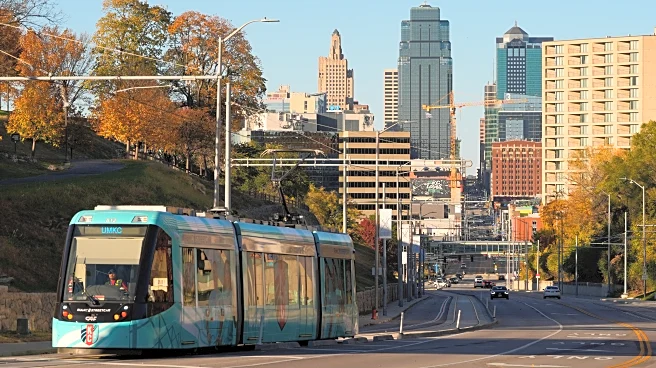KANSAS CITY, Mo. (AP) — To grasp the effects of the rush to redraw America’s congressional districts before the 2026 elections, consider one historically Black neighborhood in downtown Kansas City, Missouri,
and the small town of Boonville, population 7,800.
The 18th and Vine community is known for a museum telling the story of segregated professional baseball in the decades before Jackie Robinson broke Major League Baseball’s color barrier. Its leaders are talking about expanding the city's streetcar line to lure more visitors to its cultural and historical attractions.
About 100 miles (161 kilometers) east, Boonville leaders want federal help restoring an old railroad bridge to give cyclists a more direct route on a popular cross-state bike trail near the mostly white farming community.
The two areas are thrust together under a new map Missouri Republicans passed in September in response to President Donald Trump’s push to give the GOP another winnable seat ahead of next year's elections. Texas answered Trump's call first, tilting five seats toward Republicans, but lawmakers in both major political parties are fighting a mid-decade, state-by-state battle to squeeze extra territory out of states they control. In California, voters approved a new House map to boost Democrats.
Missouri Republicans targeted Democratic U.S. Rep. Emanuel Cleaver, shaving off portions of his Kansas City district and stretching it into Republican-heavy rural areas.
Congressional districts often mix rural and urban areas, but redoing boundaries can alter priorities and change which federal projects representatives pursue and how they pursue things like health care, housing and education funding. When Congress debates a farm bill, is protecting food assistance benefits more important than preserving crop insurance? It often depends on who's being represented.
That might explain why Robert Sylvan, an 81-year-old Kansas City resident who attends Cleaver's church, worries “the whole set of dynamics that impact us” could be upended.
Even with U.S. politics deeply polarized, there's bipartisan agreement on Sylvan's point.
Republican state Rep. Tim Taylor, who represents the Boonville area in the Legislature, said farmers Cleaver previously represented didn't feel he understood them or came around much.
“Where he lives, things are different than they are here,” said Taylor, who voted for the redistricting plan despite misgivings about it.
It's unclear how any Republican challenging Cleaver in the redrawn district would balance the needs of the two communities. So far, no likely contender is from Kansas City.
Some Kansas City residents don't expect people around 18th and Vine to get much attention if Cleaver loses. Cleaver was raised in public housing in Texas and preached about social justice as a Methodist pastor in a predominantly African American congregation.
“Naturally, 18th and Vine is kind of his baby,” said Bob Kendrick, president of the Negro Leagues Baseball Museum. “I don’t want it to be forgotten.”
Fewer than 11% of Boonville’s residents are Black, while more than 64% are in 18th and Vine. The new Missouri map could have the state going from having people of color hold two of its eight House seats to one. Non-Hispanic white people are 62% of Missouri's population but would hold 88% of its seats.
“We could potentially have folk representing us who have no interaction and have never had any interaction with people of color and have no idea of what goes on in the urban context,” said Cleaver's son, Emanuel Cleaver III.
The areas often see common needs differently. Is the pressing problem with health care cuts that they cause rural hospitals to struggle or that millions of Americans don't have insurance? An 18th and Vine resident is nearly twice as likely as a Boonville resident to have no health insurance. Boonville has been without a hospital since 2020.
Other differences: Buses stop every 15 minutes in 18th and Vine but must be prescheduled in Boonville. Kansas City leaders want more gun laws to combat violence while Republicans like Taylor have fought to expand gun rights. Trump won 67% of Boonville's vote, compared with 14% of 18th and Vine's.
The Kansas City neighborhood, celebrated for barbecue and jazz joints, hosted a 1920 meeting that founded the Negro National League, where Robinson got his start. Later, the area fell into disrepair.
Cleaver helped change that, seeking taxpayer dollars for 18th and Vine since 1989, first as a city councilman and then mayor before his two decades in Congress. The city's spending has exceeded $100 million, helped by federal grants. Most recently, Cleaver helped obtain $15.5 million in federal money to renovate the nation’s oldest Black-owned housing cooperative, which he called “one of the citadels for the African American community.”
That project followed Cleaver's efforts to bring money to neighborhoods on the historically Black side of Troost Avenue, long known as the city’s unofficial racial dividing line. It's now one of his new district's borders, which he finds outrageous.
“I feel more skeptical about the society’s direction than I did when I was a kid growing up in public housing,” Cleaver lamented during an interview at the church his son now leads.
Now, 18th and Vine also is home to all-night jazz jam sessions, a dance company, an arts center and an MLB Urban Youth Academy. Kendrick's museum hopes to raise $35 million to triple exhibit space.
If there’s unease among locals, it's that they might be priced out as taxpayer money helps transform the area. The city is working on a pedestrian plaza and a parking garage. Local officials are studying a streetcar line extension. There's no cost estimate yet, but the latest streetcar extension got $174 million in federal funds.
Carmaletta Williams, executive director of the Black Archives of Mid-America in Kansas City, an area museum, wonders about a new representative: “Will they see the value in what’s going on?”
Boonville is surrounded by row crops and cattle ranches. One local school district graduates fewer than 10 students a year.
Yet it lures tourists with the Katy Trail. At 240 miles (386 kilometers), it's the longest trail built on former rail lines in the U.S., and work on it began at nearly the same time as the rebuilding in 18th and Vine.
Taylor said after the trail's first section opened in 1990 it was instrumental in reviving a town that was “pretty much dying” when he was a teenager in the 1980s. His wife runs Taylor's Bake Shop & Espresso downtown.
Heading into Boonville, bikers detour off the railroad’s original path, crossing the Missouri River on a highway bridge that includes a designated bike path. The path leads them away from a 1932 railroad bridge, which trail riders would love to see refurbished. The city applied unsuccessfully last year for a $236,000 federal planning grant.
“The Katy Bridge is like the Eiffel Tower of Missouri if it would only be fixed,” said Annie Harmon, who runs a store in downtown Boonville called Celestial Body that sells essential oils, herbs, tie-dyed clothing and crystals.
Missouri has received $30 million in federal funds over the years for the Katy Trail and a related trail-building effort that cycling enthusiasts hope will loop almost 450 miles (724 kilometers), said Brandi Horton, a spokeswoman for the Rails to Trails Conservancy, a Washington-based nonprofit.
“You can’t do trail development at this scale,” Horton said, “without the dollars and the investment that the federal government can uniquely provide.”
___
Hanna reported from Topeka, Kan.












